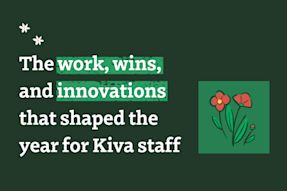This post was co-written by Chad Sterbenz, Kiva's Chief Investment Officer, and Matthew Davie, Kiva's Chief Strategy Officer.
We often talk about the need for global financial inclusion. By one measure — account ownership — there are 1.7 billion adults in the world without access to the formal financial sector. They lack access to even the most basic deposit accounts that enable so many aspects of everyday life for the financially included. The products they do access are typically more expensive and can perpetuate a cycle of poverty. The need for better global financial inclusion is clear.
We rarely talk about the opportunity presented by global financial inclusion. In a recent study, serving the financial needs of the unbanked could trigger over $4 trillion in new deposits, over $2 trillion of formal lending, and drive almost $4 trillion of new GDP growth in emerging markets.
Yes — trillion with a “T”.
This isn’t the cost to bring financial inclusion, this is the resulting growth in financial assets and income from including 1.7 billion adults into the formal sector. This is capital that can be deployed and generate returns for investors once the obstacles between that capital and the unbanked world are cleared. It’s is a multi-trillion dollar market that could be served using largely the same innovative products and services that are already available across the existing global financial sector.
On an absolute scale, trillions of dollars is a massive amount of capital. But financial inclusion is a global problem, so let’s put this amount into a global context:
The global bond market in 2017 was $100 trillion USD. So, the total flow of capital likely needed to fund future growth in global financial inclusion — for 1.7 billion adults — is only a tiny fraction (1–2%) of the global bond market.
In that light, a few trillion dollars starts to seem like a feasible investment, especially considering the social returns and other impacts of expanding financial inclusion. And importantly, mobilization of this capital is for return-seeking investments, not expenses. Once global financial inclusion is achieved, this capital can compete based on yield with other global asset allocations (like bonds!).
And very importantly: we don’t need to fund this vision with the delivery of grants and goodwill alone. In the very near future, existing market forces could — and should — and must — be harnessed to achieve global financial inclusion.
Why hasn’t this happened yet?
There are three primary challenges in the financial lives of the unbanked.
First, financial service providers (FSPs) that work to serve excluded populations almost universally lack access to adequate information about their borrowers’ financial lives. In short: they don’t know if a borrower is cross-indebted or has defaulted recently on a loan because this information is often not reported to a reliable credit bureau.
Net result: FSPs have to price additional risk due to the lack of information into their products and services. This leads to higher overall prices for borrowers, the misallocation of pricing across borrowers and products, and less total deployment of capital.
Second, financial services are very expensive to deliver in the unbanked world, which consists largely of cash-based transactions and poor physical infrastructure. These costs are so high that many banks in developing countries do not even attempt to serve harder-to-reach populations or customers with smaller financing needs. Instead, a patchwork of mostly under-resourced micro-finance institutions (MFIs), credit cooperatives, and savings and loans groups work to serve the financial needs of those outside of the formal financial sector.
Net result: billions of people have limited (or zero) access to most financial services and must pay for the higher operating costs of a patchwork of smaller institutions.
Third, this higher price environment creates a major problem for many borrowers. There are limited productive uses of credit that can repay the very high rates that FSPs charge. There often needs to be a very strong need (e.g., emergency health) or a very strong economic incentive (e.g., a proven business with high return on assets) to justify taking such a loan.
Net result: Borrowers are limited as to when and where they will consider using loans in the informal sector because they’re too expensive.
This cycle has “trapped” many in the informal sector and made it very difficult to deploy additional productive investment capital into the unbanked world.
Part of the reason the core problems above have not yet been solved is because global banking systems were not built to include the developing world. This wasn’t by intent — it’s because connectivity was both very different and very difficult when the foundation of today’s global banking systems were built over a century ago. Think back even just 30 years — banking typically consisted of physically visiting a bank branch, or possibly using a combination of telephone and fax machine to interact remotely. These options weren’t available in places that lacked the physical infrastructure or economic activity to support brick and mortar branches or copper wire for communications. Poorer regions — and especially developing countries — were almost entirely skipped by the global financial sector due in part to this lack of viability.
How can we solve this problem at a global scale?
If the desired outcome is a competitive market for FSPs in the unbanked world that leads to (lower) market rates for end borrowers, then it is necessary for this market to have adequate information to appropriately price risk — just like existing global financial markets. Where possible, this includes the need to ‘leapfrog’ over 30 years of legacy technologies to modern financial and business practices that can reduce operational overhead costs by an order of magnitude.
There are substantial efforts to bring digital inclusion to all by 2030, and to bring identity and credit reporting services on top of this digital infrastructure. (More about internet in the developing world here.) Over time, this can enable conditions for FSPs to better price risk associated with informal sector lending and other financial services, and in turn encourage more, better, cheaper financial products and services for excluded populations. The beginnings of a competitive market environment.
This creates massive opportunity for both FSPs and unbanked borrowers.
Yield opportunity for FSPs
There are incredibly wide variations in the quality, quantity, and cost of financial products and services in the unbanked world. To look at the global yield opportunity for FSPs, we’ll do some math using averages.
On the revenues side, FSPs earn the rate they charge. Interest rates vary widely in the unbanked world, but middle-of-the-road numbers are 30–50% APR. Let’s use 40% APR as the rate charged to the end borrower, and thus the top-line revenues to FSPs.
On the cost sides, FSPs must cover the operational load to service informal-sector loans as well as the default risk. As a reminder, operational costs in the unbanked world are high. For example, an informal-sector FSP might have to send an agent driving hours on a scooter to a remote village to meet and transact with borrowers in cash. This can easily be half of the end borrower APR, so let’s use 20% APR for the operational cost. Then there’s default risk. Here, we can use Kiva’s 13-years of loaning $1.3 billion USD in 90+ countries worldwide, which has an annualized borrower default rate of less than 2%. So, we’ll use 2% APR as the borrower default risk.
So, here’s the math:
Revenue = 40% APR
Cost = 20% APR (operational) + 2% APR (default) = 22% APR
Even incorporating in ~5% inflation for developing countries, this establishes a ‘floor’ rate of return in this example of 13%. There is a lot of potential yield for FSPs (and their funders) at at 13% rate of return. And for context, the $100 trillion USD global bond market typically yields less than 3%. And this doesn’t include the likely savings in operational costs that come from digital inclusion. If end borrowers are digitally connected to FSPs, the cost to service their loans could be substantially reduced.
So — there’s a massive global economic opportunity to create a market that can provide above-market returns while driving the market rate for credit in the unbanked world to competitive levels.
‘Fair pricing’ opportunity for borrowers
Competitive rates for consumer loans can create an unbelievable opportunity for excluded borrowers. Market forces combined with technology-driven operational efficiency gains could move the cost of capital for these borrowers well below the current 40% APRs they currently pay. As a comparison, the default (‘charge off’) rate for US credit cards is generally about 4% (surging to 10% in a recession) — and typical rates on credit cards are only 12–15%.
It’s entirely possible that the combination of digital inclusion and financial inclusion could drive rates for unbanked customers to the same 12–15% floor over time (after adjusting for inflation per market). This would be truly life-changing for the average unbanked borrower — and represent fair pricing of their 2% default rate. Not only that, but unbanked borrowers would be able to consider many more viable applications of credit — the potential for productive and sustainable uses for a 12% APR product are far greater than those for a 40% product.
Inclusion by default
The time is approaching — driven by technology penetration and improvements in risk assessment in the unbanked world— when financial markets and institutions will be able to look at financial inclusion of the billions of unbanked and underbanked people through the lens of opportunity.
The lens of need remains incredibly important. But the existing systems that primarily deploy concessionary capital are no longer alone — they can be substantially leveraged by the global financial market to bring trillions of dollars to the unbanked world.
As roadblocks to inclusion are removed, the possibility of building an inclusive system for the developing world is opened. It will take a coalition of government, non-government, profit, non-profit, and community organizations to truly enable global financial inclusion. If we make the right investments in inclusive financial systems now, it’s possible that the future will be much different, and much improved, for the 1.7 billion adults who are unbanked today. This might present the most profound impact opportunity we will see in a generation. We could do in a decade what has been blocked for a century — bring financial inclusion to every adult on the planet.
And it’s a massive opportunity for the global financial sector.
PREVIOUS ARTICLE
Employee spotlight: Amit Pansare →NEXT ARTICLE
Instead of finding jobs, Allan created them in Oakland, CA →














